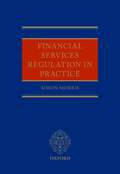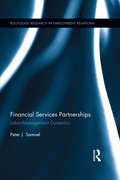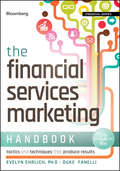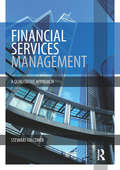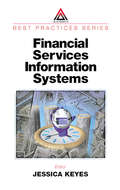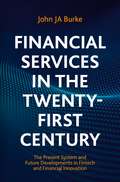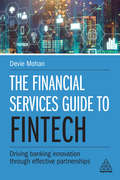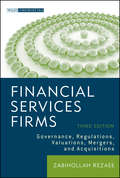- Table View
- List View
Financial Services Regulation in Practice
by Simon MorrisThis book explains how to deal with legal, compliance, and enforcement issues faced by banks and other financial institutions and their legal advisers. It focuses on the practical application of the generally applicable regulations and rules under the Financial Services and Markets Act 2000 governing the financial services sector as it changed and developed during and after the financial crisis. The book considers the key changes made by the Financial Services Act 2012 and the Financial Services (Banking Reform) Act 2013 as well as policy developments brought about by the change in regime from the Financial Services Authority to the Prudential Regulation Authority and Financial Conduct Authority. Guidance is given on the application and enforcement of the rules taking all relevant sources into account including speeches and announcements by regulatory authorities, policy documents and pronouncements, practice developments, court cases, tribunal decisions, and enforcement proceedings. Providing real insight into the practical, legal, and policy issues affecting all dealing with the post-crisis regulatory environment, this book is essential for all advising on legal matters, compliance and enforcement in the financial sector.
Financial Services Regulation in Practice
by Simon MorrisThis book explains how to deal with legal, compliance, and enforcement issues faced by banks and other financial institutions and their legal advisers. It focuses on the practical application of the generally applicable regulations and rules under the Financial Services and Markets Act 2000 governing the financial services sector as it changed and developed during and after the financial crisis. The book considers the key changes made by the Financial Services Act 2012 and the Financial Services (Banking Reform) Act 2013 as well as policy developments brought about by the change in regime from the Financial Services Authority to the Prudential Regulation Authority and Financial Conduct Authority. Guidance is given on the application and enforcement of the rules taking all relevant sources into account including speeches and announcements by regulatory authorities, policy documents and pronouncements, practice developments, court cases, tribunal decisions, and enforcement proceedings. Providing real insight into the practical, legal, and policy issues affecting all dealing with the post-crisis regulatory environment, this book is essential for all advising on legal matters, compliance and enforcement in the financial sector.
Financial Services Partnerships: Labor-Management Dynamics (Routledge Research in Employment Relations)
by Peter SamuelThe purpose of this book is to evaluate the debate on partnership, using original research data. Samuel provides a novel categorisation with which to synthesise and clarify a highly diverse literature on labour-management partnership, thus helping to refine the contemporary partnership debate. Secondly, he clarifies the circumstances under which ‘effective’ labour-management partnership is possible, while simultaneously elaborating why the achievement of ‘mutual gains’ is highly improbable in a liberal-market context. Thirdly, the book presents an integrated analysis of the interplay between macro-, meso- (industry) and micro-level factors. Fourthly, the research design enables the study to go beyond the case studies to make defendable empirical generalizations at the level of the industry. Finally, it advances a theoretical explanation of labour-management partnerships in ‘liberal market’ economies by bridging two opposing neo-institutional positions in the social sciences.
Financial Services Partnerships: Labor-Management Dynamics (Routledge Research in Employment Relations)
by Peter SamuelThe purpose of this book is to evaluate the debate on partnership, using original research data. Samuel provides a novel categorisation with which to synthesise and clarify a highly diverse literature on labour-management partnership, thus helping to refine the contemporary partnership debate. Secondly, he clarifies the circumstances under which ‘effective’ labour-management partnership is possible, while simultaneously elaborating why the achievement of ‘mutual gains’ is highly improbable in a liberal-market context. Thirdly, the book presents an integrated analysis of the interplay between macro-, meso- (industry) and micro-level factors. Fourthly, the research design enables the study to go beyond the case studies to make defendable empirical generalizations at the level of the industry. Finally, it advances a theoretical explanation of labour-management partnerships in ‘liberal market’ economies by bridging two opposing neo-institutional positions in the social sciences.
The Financial Services Marketing Handbook: Tactics and Techniques That Produce Results (Bloomberg Financial #150)
by Evelyn Ehrlich Duke FanelliThe roadmap to success for financial professionals using real-world examples, practical how-to's, and a structured approach to marketing strategy and tactics that covers the basics for beginners and inspires new ideas for marketing pros The Financial Marketing Services Handbook, Second Edition gives sales and marketing practitioners the practical tools and best practices they need both to improve their job performance and their retail and institutional marketing strategies. The FSM Handbook guides marketing and sales professionals working in an industry characterized by cut-throat competition, client mistrust, transformative technologies, and ever-changing regulation, to understand the practical steps they must take to turn these threats into opportunities. Providing invaluable information on how to target, win, and retain profitable customers, the book presents an overview of the basic marketing functions—segmentation, positioning, brand building, situational analyses, and tactical planning—as they relate specifically to the financial services industry. With up-to-date case studies, showing what has worked and, more tellingly, what hasn't, the book demonstrates how to effectively utilize the marketer's toolbox—from advertising and public relations to social media and mobile marketing. Discusses how social media (Twitter, Facebook, blogs, review sites) impact branding and sales Packed with new information on landing pages, email success factors, and smartphone apps Demonstrates how behavioral economics affect marketing strategy Case studies and charts are fully revised and updated The financial industry is under intense pressure to improve profits, retain high-value clients, and maintain brand equity without straining budgets. The first edition has become an industry-standard reference book and The Financial Services Marketing Handbook, Second Edition gives sales and marketing professionals even more of the information they need to stretch value from each marketing dollar.
The Financial Services Marketing Handbook: Tactics and Techniques That Produce Results (Bloomberg Financial #150)
by Evelyn Ehrlich Duke FanelliThe roadmap to success for financial professionals using real-world examples, practical how-to's, and a structured approach to marketing strategy and tactics that covers the basics for beginners and inspires new ideas for marketing pros The Financial Marketing Services Handbook, Second Edition gives sales and marketing practitioners the practical tools and best practices they need both to improve their job performance and their retail and institutional marketing strategies. The FSM Handbook guides marketing and sales professionals working in an industry characterized by cut-throat competition, client mistrust, transformative technologies, and ever-changing regulation, to understand the practical steps they must take to turn these threats into opportunities. Providing invaluable information on how to target, win, and retain profitable customers, the book presents an overview of the basic marketing functions—segmentation, positioning, brand building, situational analyses, and tactical planning—as they relate specifically to the financial services industry. With up-to-date case studies, showing what has worked and, more tellingly, what hasn't, the book demonstrates how to effectively utilize the marketer's toolbox—from advertising and public relations to social media and mobile marketing. Discusses how social media (Twitter, Facebook, blogs, review sites) impact branding and sales Packed with new information on landing pages, email success factors, and smartphone apps Demonstrates how behavioral economics affect marketing strategy Case studies and charts are fully revised and updated The financial industry is under intense pressure to improve profits, retain high-value clients, and maintain brand equity without straining budgets. The first edition has become an industry-standard reference book and The Financial Services Marketing Handbook, Second Edition gives sales and marketing professionals even more of the information they need to stretch value from each marketing dollar.
Financial Services Marketing: An International Guide to Principles and Practice
by Christine Ennew Nigel Waite Roisin WaiteThis new edition balances the theoretical and the practical for advanced undergraduates, those specialising in financial services at postgraduate level, individuals undertaking professional courses such as those offered by the IFS School of Finance, and employees working within the financial services sector. Ennew & Waite draw from global business cases in both B2B and B2C marketing, taking a unique approach in terms of structure by splitting discussion between marketing for acquisition and marketing for retention. This fully updated and revised second edition features: A revised approach to the industry in the light of the global financial crisis, including ethical considerations, consumer confidence issues, and new approaches to regulation New sections on e-commerce and its impact on customer relationships New case studies and vignettes A new companion website to support teaching, including PowerPoint slides, test bank questions, additional cases and cameo video mini-lectures. Financial Services Marketing 2e will help the student and the practitioner to develop a firm grounding in the fundamentals of financial services strategy, customer acquisition and customer development. Reflecting the realities of financial services marketing in an increasingly complex sector, it provides the most up-to-date, international and practical guide to the subject available.
Financial Services Marketing: An International Guide to Principles and Practice
by Christine Ennew Nigel Waite Roisin WaiteThis new edition balances the theoretical and the practical for advanced undergraduates, those specialising in financial services at postgraduate level, individuals undertaking professional courses such as those offered by the IFS School of Finance, and employees working within the financial services sector. Ennew & Waite draw from global business cases in both B2B and B2C marketing, taking a unique approach in terms of structure by splitting discussion between marketing for acquisition and marketing for retention. This fully updated and revised second edition features: A revised approach to the industry in the light of the global financial crisis, including ethical considerations, consumer confidence issues, and new approaches to regulation New sections on e-commerce and its impact on customer relationships New case studies and vignettes A new companion website to support teaching, including PowerPoint slides, test bank questions, additional cases and cameo video mini-lectures. Financial Services Marketing 2e will help the student and the practitioner to develop a firm grounding in the fundamentals of financial services strategy, customer acquisition and customer development. Reflecting the realities of financial services marketing in an increasingly complex sector, it provides the most up-to-date, international and practical guide to the subject available.
Financial Services Marketing: An International Guide to Principles and Practice
by Christine Ennew Nigel Waite Roisin WaiteNow in its 3rd edition, Financial Services Marketing offers a balanced and useful guide to the topic that is both conceptual and practical. The authors have drawn from extensive international experience to ensure that this text will resonate with users across the globe. This edition is complemented by numerous international references, examples and case studies featuring companies such as American Express, Direct Line, Barclays, NatWest RBS, Aviva and HSBC. This fully updated and revised edition features: An expanded section on regulation which has international reach and addresses the post-Brexit world Greatly expanded coverage of digital marketing at both the strategic and tactical levels New material on how to improve a company’s trustworthiness and safeguard a culture that is customer-focussed New examples, vignettes and case studies that showcase best practice from around the world B2B and B2C marketing Upgraded PowerPoint support on the companion website Financial Services Marketing 3e will be hugely beneficial to academic students of marketing and finance, as well as essential reading to those industry-based and studying for professional qualifications.
Financial Services Marketing: An International Guide to Principles and Practice
by Christine Ennew Nigel Waite Roisin WaiteNow in its 3rd edition, Financial Services Marketing offers a balanced and useful guide to the topic that is both conceptual and practical. The authors have drawn from extensive international experience to ensure that this text will resonate with users across the globe. This edition is complemented by numerous international references, examples and case studies featuring companies such as American Express, Direct Line, Barclays, NatWest RBS, Aviva and HSBC. This fully updated and revised edition features: An expanded section on regulation which has international reach and addresses the post-Brexit world Greatly expanded coverage of digital marketing at both the strategic and tactical levels New material on how to improve a company’s trustworthiness and safeguard a culture that is customer-focussed New examples, vignettes and case studies that showcase best practice from around the world B2B and B2C marketing Upgraded PowerPoint support on the companion website Financial Services Marketing 3e will be hugely beneficial to academic students of marketing and finance, as well as essential reading to those industry-based and studying for professional qualifications.
Financial Services Management: A Qualitative Approach
by Stewart FalconerSweeping changes have taken place within financial services over the course of the past thirty years in response to a variety of influences, such as changes in customer attitudes, an evolving regulatory environment, innovations in information technology and the intense level of competition within the sector. In addition, the global financial crisis has had a huge impact on the perceptions of stakeholders and on the reputations of organisations operating in financial services. This new textbook introduces management with a focus on concepts, theories and skills particularly suited to the financial services sector. Beginning with an overview of the development of management theories through history, the text then focuses on topical issues such as organizational design, the use of information technology, the development of a marketing orientation, social responsibility, ethics and, the influence of the external business and social environments and organizational development and the management of change. This practical textbook mixes theory with application throughout - employing a variety of case studies and examples to render the topic both accessible and memorable. The result is a resource that will help lecturers teaching management skills and students keen to develop their financial services understanding.
Financial Services Management: A Qualitative Approach
by Stewart FalconerSweeping changes have taken place within financial services over the course of the past thirty years in response to a variety of influences, such as changes in customer attitudes, an evolving regulatory environment, innovations in information technology and the intense level of competition within the sector. In addition, the global financial crisis has had a huge impact on the perceptions of stakeholders and on the reputations of organisations operating in financial services. This new textbook introduces management with a focus on concepts, theories and skills particularly suited to the financial services sector. Beginning with an overview of the development of management theories through history, the text then focuses on topical issues such as organizational design, the use of information technology, the development of a marketing orientation, social responsibility, ethics and, the influence of the external business and social environments and organizational development and the management of change. This practical textbook mixes theory with application throughout - employing a variety of case studies and examples to render the topic both accessible and memorable. The result is a resource that will help lecturers teaching management skills and students keen to develop their financial services understanding.
Financial Services Litigation
by HHJ Jonathan Russen QC Robin KinghamThis book primarily provides assistance to litigators who find themselves acting for or against firms in contentious regulatory matters. The material covered is broad in that it covers matters of civil, criminal, administrative, and public law. It is also highly focused in that it is intended to act as a practical handbook for litigators; detailed explanations are given of practice, procedure, evidence, and remedies at the expense of general commentary on the non-contentious aspects of financial regulation. The book starts with two chapters that are primarily contextual. Chapter 1 provides an overview of the UK financial regulators whilst paying particular attention to the relationships between them and the ways in which those interactions can pose problems for litigators and the firms they represent. Chapter 2 summarises the authorisation process and its procedures, as well as the Senior Managers and Certification Regime. In both cases, it provides practical advice for firms and individuals in composing and submitting applications for authorisation and approval. Chapter 3 deals with the increasingly important topic of investigations and information gathering. It pays particular attention to the settlement of investigations and the FCA's procedures for determining discounts. The heart of this book is found in Chapters 4-7, which cover the various forums in which firms can be challenged for failing to adhere to regulatory standards. Unlike many works dealing with financial services regulation, which so often seem to focus on civil liability, this book aspires to be equally helpful to the criminal litigator. Criminal liability is therefore split in two. Chapter 4 covers practice, procedure, and evidence. Chapter 5 covers the substantive offences, defences, and sentencing. Civil liability is found in Chapters 6 and 7. Civil enforcement action taken by regulators, including RDC procedure, penalties, and an analysis of the basis and scope of the raft of potential remedies available to the regulator, are covered in Chapter 6. Individual action by investors and consumers is considered in Chapter 7 alongside wider legal principles that may come into play such as litigation. This chapter for the first time includes a detailed analysis of the types of claims often encountered by firms, including case studies on PPI and interest rate hedging products. Redress, complaints, the Financial Ombudsman Service, and relevant procedure are analysed in Chapter 8. Finally, Chapter 9 provides an overview of the independent methods of challenging regulators, including judicial review and the Financial Services Complaints Commissioner.
Financial Services Litigation
by HHJ Jonathan Russen QC Robin KinghamThis book primarily provides assistance to litigators who find themselves acting for or against firms in contentious regulatory matters. The material covered is broad in that it covers matters of civil, criminal, administrative, and public law. It is also highly focused in that it is intended to act as a practical handbook for litigators; detailed explanations are given of practice, procedure, evidence, and remedies at the expense of general commentary on the non-contentious aspects of financial regulation. The book starts with two chapters that are primarily contextual. Chapter 1 provides an overview of the UK financial regulators whilst paying particular attention to the relationships between them and the ways in which those interactions can pose problems for litigators and the firms they represent. Chapter 2 summarises the authorisation process and its procedures, as well as the Senior Managers and Certification Regime. In both cases, it provides practical advice for firms and individuals in composing and submitting applications for authorisation and approval. Chapter 3 deals with the increasingly important topic of investigations and information gathering. It pays particular attention to the settlement of investigations and the FCA's procedures for determining discounts. The heart of this book is found in Chapters 4-7, which cover the various forums in which firms can be challenged for failing to adhere to regulatory standards. Unlike many works dealing with financial services regulation, which so often seem to focus on civil liability, this book aspires to be equally helpful to the criminal litigator. Criminal liability is therefore split in two. Chapter 4 covers practice, procedure, and evidence. Chapter 5 covers the substantive offences, defences, and sentencing. Civil liability is found in Chapters 6 and 7. Civil enforcement action taken by regulators, including RDC procedure, penalties, and an analysis of the basis and scope of the raft of potential remedies available to the regulator, are covered in Chapter 6. Individual action by investors and consumers is considered in Chapter 7 alongside wider legal principles that may come into play such as litigation. This chapter for the first time includes a detailed analysis of the types of claims often encountered by firms, including case studies on PPI and interest rate hedging products. Redress, complaints, the Financial Ombudsman Service, and relevant procedure are analysed in Chapter 8. Finally, Chapter 9 provides an overview of the independent methods of challenging regulators, including judicial review and the Financial Services Complaints Commissioner.
Financial Services Law Guide
by Andrew HaynesA comprehensive guide to the rules and regulations that govern the UK financial services industry, providing:- Analysis of the various laws and regulations and how they impact on customer relations and retail products- An outline of the protection given to clients' money and the functioning of the prudential requirements- An explanation of the rationale and operation of enforcement procedures- Details of requirements as they apply to professionals who engage in financial services activities as an incidental part of their professional activities- A consideration of recently implemented EU initiativesThe fifth edition has been fully updated in line with the post-EU regime and in addition includes updates to: - the new investments and investment activities and the FCA rules and their impact- the FCA authorisation procedures and their impact- the approved persons regime- the rules and, in particular, their applications in relation to retail products and customer relations- the rules in relation to professionalsas well as coverage of:- the EU Market Abuse Regulation- 4th and 5th Money Laundering Directives in their UK form including additional examples of enforcement actions and prosecutions and the lessons to be learned- new case law in relation to enforcement and the lessons learnedCovering the latest developments, this valuable text is set out in the context of common practice and is indispensable for those working within or otherwise associated with the financial services industry, namely lawyers, compliance officers, auditors, financial advisers, consultants, academics and students.
Financial Services Law and Distributed Ledger Technology: Regulating Cryptoassets and Decentralised Finance (Elgar Financial Law and Practice series)
by Brendan McGurk Stefan ReichenbachThis incisive book examines the extent to which existing UK financial service regulations can be applied to digital assets and decentralised financial services provided by distributed networks. Brendan McGurk and Stefan Reichenbach consider the wider legal issues beyond regulatory enforcement, attributable to the use of distributed ledger technology based financial services. Key Features:Comprehensive examination of the nature and application of distributed ledgers in the context of financial servicesAnalyses the proprietary nature of cryptoassets and their amenability to financial services regulation as a form of propertyDetailed consideration of the extent to which existing financial services law governs cryptoassets and forms of decentralised financeSector specific analysis of the use of digital assets as securities, within the distributed payment systems, and in supporting lending and insurance servicesConsideration of the complexities in identifying the appropriate jurisdiction and applicable laws governing crypto disputesIn-depth exploration of the remedies and dispute resolution methods available to holders of digital assetsDiscussing the benefits and risks associated with the application of DLT, this informative book will be fundamental for financial services practitioners, including solicitors, barristers, and in-house counsel, as well as industry specialists operating within the decentralised finance sphere. It will also be beneficial for academics and researchers in finance and banking law, and technology, media, and telecommunications law.
Financial Services Information Systems
by Jessica KeyesThe calculus of IT support for the banking, securities, and insurance industries has changed dramatically and rapidly over the past few years. Consolidation and deregulation are creating opportunities and challenges never before seen. Unheard of just a few years ago, e-commerce has given birth to new infrastructures and departments needed to suppor
Financial Services in Wales 1991
by G. BricaultPublisher's Note The third edition of Financial Services in Wales The data provided in this publication to correct to (formerly entitled Corporate Financial Services in the best of the Publishers knowledge and belief at Wales) has been completely revised and updated the time of going to press at the end of 1990. via questionnaires sent to all the second edition's entrants and via telephone follow-up where No responsibility can be accepted either by the necessary. Many new organisations have also publishers or the sponsors of this directory for any been added, reflecting the continueing dynamic action taken by a reader as a result of using this growth of the Welsh financial services sector. directory. Once again the Publishers would like to thank all As a matter of sensible business practice, any those organisations which contributed data for reader choosing to make further use of the publication in the directory, as well as the information given in this publication is advised to advertisers and -in particular -the sponsors, the take specific professional advice to cover the names of which are listed on the title page of the particular course of action he may wish to follow. directory. 2 unlike some other regions Wales is not overheated and continues to offer great opportunities for FOREWORD companies in this sector looking to expand or re locate. I look foward to outstanding future growth.
Financial Services in the Twenty-First Century: The Present System and Future Developments in Fintech and Financial Innovation
by John JA BurkeThis textbook covers financial systems and services, particularly focusing on present systems and future developments. Broken into three parts, Part One establishes the public institutional framework in which financial services are conducted, defines financial service systems, critically examines the link between finance, wealth and income inequality, and economic growth, challenges conventional paradigms about the raison d’être of financial institutions and markets, and considers the loss of US financial hegemony to emerging regional entities [BRICS]. Part Two focuses on financial innovation by explaining the impact of the following technologies: cryptography, FinTech, distributed ledger technology, and artificial intelligence. Part Three assesses to what extent financial innovation has disrupted legacy banking and the delivery of financial services, identifies the main obstacles to reconstructing the whole financial system based upon “first principles thinking”: Nation State regulation and incumbent interests of multi-national companies, and provides a cursory description of how the pandemic of COVID-19 may establish a “new normal” for the financial services industry. Combining rigorous detail alongside exercises and PowerPoint slides for each chapter, this textbook helps finance students understand the wide breadth of financial systems and speculates the forthcoming developments in the industry.
Financial Services in Europe: An Introductory Overview
by Martijn Van EmpelThis very useful volume provides a ‘ground up’ survey, from a business law point of view, of the concept of finance as a vital component of the economic structure of the European Communities. In deeply informed detail it describes the architecture of the financial system, its institutions (banks, stock exchanges, etc.), the variety of financial instruments, the progress of liberalisation and harmonisation initiatives in Europe, relevant EC legislation, regulation of capital markets and securities, the development of international financial law, and the management of legal risk. The authors are all outstanding authorities in the field, with extensive experience both as practitioners and academics in many European countries and elsewhere in the world. The essays in this book grew out of lecture courses delivered under the auspices of the PALLAS Consortium organised by nine universities in seven EU Member States. Among the wealth of material covered, the reader will find, among much else, precise and interrelated explanations of the following: the transferring, sharing and insuring of risks; relevant contractual arrangements; the intermediation and distribution functions of financial institutions; primary markets versus secondary markets; money markets versus capital markets; stock market ‘players’; the role of letters of credit; pension funds; and the management of payment systems; The book is especially valuable for its middle way between a ‘top down’ EU regulatory perspective and a strictly national framework—a method that supports and reinforces a practice-oriented approach corresponding to the ‘real world’ in which domestic and cross-border aspects of financial services are inevitably intertwined. Practitioners and business law students will find the book extraordinarily useful for its expert guidance and insight in clarifying many situations involving financial services and in resolving typical problems.
The Financial Services Guide to Fintech: Driving Banking Innovation Through Effective Partnerships
by Devie MohanFintech has emerged as one of the fastest growing sectors in the financial services industry and has radically disrupted traditional banking. However, it has become clear that in order for both to thrive the culture between fintech and incumbent firms will need to change from one of competition to one of collaboration. The Financial Services Guide to Fintech looks at this trend in detail, using case studies of successful partnerships to show how banks and fintech organizations can work together to innovate faster and increase profitability. Written by an experienced fintech advisor and influencer, this book explains the fundamental concepts of this exciting space and the key segments to have emerged, including regtech, robo-advisory, blockchain and personal finance management. It looks at the successes and failures of bank-fintech collaboration, focusing on technologies and start-ups that are highly relevant to banks' product and business areas such as cash management, compliance and tax. With international coverage of key markets in Europe, Africa, Asia, Latin America and the US, The Financial Services Guide to Fintech offers practical guidance, use cases and business models for banks and financial services firms to use when working with fintech companies.
The Financial Services Guide to Fintech: Driving Banking Innovation Through Effective Partnerships
by Devie MohanFintech has emerged as one of the fastest growing sectors in the financial services industry and has radically disrupted traditional banking. However, it has become clear that in order for both to thrive the culture between fintech and incumbent firms will need to change from one of competition to one of collaboration. The Financial Services Guide to Fintech looks at this trend in detail, using case studies of successful partnerships to show how banks and fintech organizations can work together to innovate faster and increase profitability. Written by an experienced fintech advisor and influencer, this book explains the fundamental concepts of this exciting space and the key segments to have emerged, including regtech, robo-advisory, blockchain and personal finance management. It looks at the successes and failures of bank-fintech collaboration, focusing on technologies and start-ups that are highly relevant to banks' product and business areas such as cash management, compliance and tax. With international coverage of key markets in Europe, Africa, Asia, Latin America and the US, The Financial Services Guide to Fintech offers practical guidance, use cases and business models for banks and financial services firms to use when working with fintech companies.
Financial Services, Globalization and Domestic Policy Change (International Political Economy Series)
by William D. ColemanThe global scope of the changes in the international financial and monetary systems ensured that no nation-state could protect itself from their effects. The quarter-century, 1970-95, included the most extensive legislative overhaul of financial services policy since the Great Depression, if not the greatest set of changes ever. This book examines how five such states - Canada, France, Germany, UK, USA - adapted by reforming their financial services policies.
Financial Services Firms: Governance, Regulations, Valuations, Mergers, and Acquisitions (Wiley Corporate F&A #14)
by Zabihollah RezaeeIndispensable coverage of new federal regulatory reforms and federal financial issues An essential guide covering new federal regulatory reforms and federal financial issues Financial Institutions, Valuations, Mergers and Acquisitions, Third Edition presents a new regulatory framework for financial institutions in the post-bailout era. Provides valuable guidance to assess risks, measure performance and conduct valuations processes to create shareholder value Covers the protection of other stakeholders, including customers, regulators, government, and consumers Offers an up-to-date understanding of financial institutions, their challenges, and their opportunities in the post-Sarbanes-Oxley era Over the past decade, substantial changes have taken place in the structure and range of products and services provided by the financial services industry. Get current coverage of these changes that have transformed both traditional organizations such as banks, thrifts, and insurance companies, as well as securities providers, asset management companies and financial holding companies with the up-to-the-minute coverage found in Financial Institutions, Valuations, Mergers and Acquisitions, Third Edition.
Financial Services Firms: Governance, Regulations, Valuations, Mergers, and Acquisitions (Wiley Corporate F&A #14)
by Zabihollah RezaeeIndispensable coverage of new federal regulatory reforms and federal financial issues An essential guide covering new federal regulatory reforms and federal financial issues Financial Institutions, Valuations, Mergers and Acquisitions, Third Edition presents a new regulatory framework for financial institutions in the post-bailout era. Provides valuable guidance to assess risks, measure performance and conduct valuations processes to create shareholder value Covers the protection of other stakeholders, including customers, regulators, government, and consumers Offers an up-to-date understanding of financial institutions, their challenges, and their opportunities in the post-Sarbanes-Oxley era Over the past decade, substantial changes have taken place in the structure and range of products and services provided by the financial services industry. Get current coverage of these changes that have transformed both traditional organizations such as banks, thrifts, and insurance companies, as well as securities providers, asset management companies and financial holding companies with the up-to-the-minute coverage found in Financial Institutions, Valuations, Mergers and Acquisitions, Third Edition.
